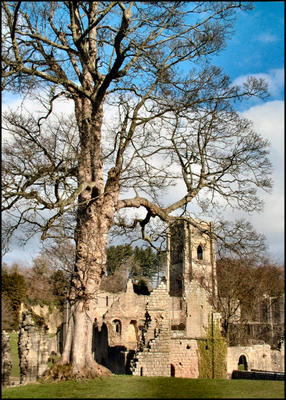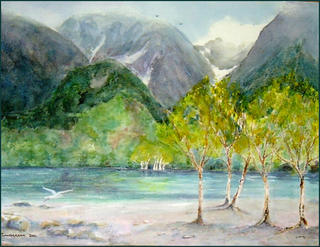Sunday, November 27, 2005
Being a staunch Englishman, I will never openly admit to my friends in the USA that any part of the language they speak there comes close to being real English! (there, now I've probably lost those friends too.) However, I will privately admit to you that I do like the American word 'Fall' for Autumn - such a poetic word, which instantly conjures up the image of red and gold leaves slowly spinning to the ground.
This is by way of sharing a few images of Scotland, created while we spent a week up in the Trossachs, a magical area in the Highlands, in September. We stayed in a typical Scottish tower-house - Tigh Mor - on the shore of Loch Achray, one of the many properties owned by a Holiday company we invest in.
This is Tigh Mor - Gaelic for 'Big House' - nestling in the multi-coloured pine forest, showing in glorious autumn colour:

We had a journey of some 240 miles north from our home in North Yorkshire, so we were pretty weary by the time we arrived there - just time to unpack, settle in, grab a meal and shower, then tumble into bed for some much-needed rest.
My wife woke around seven next morning and went to open the curtains to see what kind of day we had for our first morning; she gasped, called to me 'Come and look!', and pulled the long curtains fully back. I took a look and grabbed my camera.
~~~~~~~~~~~~~~~~
First Morning

At this time of morning, the sun had scarcely reached the loch and the foreground was quite dark. The sky held this lovely pearlescent effect, and a band of radiation mist hovered over the water, obscuring most of the distant hill. Forgetting our obligatory early-morning tea for a while, we gazed at the scene until the sun rose sufficiently to disperse the mist and light up the soft sky. This was the first morning of our holiday, but it also felt like the first morning of creation, everything was so still and solemn. It wasn't until we returned home and I processed my photos that I created this haiga.
~~~~~~~~~~~~~~~~~~~~~~~~~~~
When we stay in Scotland we usually divide our time between walking in the hills around Tigh Mor - as far as our creaking bodies will take us - and driving to favourite spots, where Jill paints and I take photographs. This September, however, there was a threatened truck-drivers' blockade of petroleum refineries and depots (in protest at rising prices and high taxes), so we daren't drive around much for fear of emptying our tank and being unable to fill up to get back home.
This gave us a first-class excuse to spend more time down by the loch, lazing around, drawing, brewing tea, thinking deeply (me) - though Jill claimed I was dozing, my mind was actually a whirl of activity, planning all those photos I was going to take, and the clever things I was going to write. We men get through an awful lot of thinking.
One of the results of all this mental activity was this image of reeds at the edge of the loch, with a broken branch lying by them; and subsequently, the idea of this haiga comparing the strength of branches with the flexibility of the reeds. The idea of flexibility versus strength is a very old one in Eastern philosophy, dating back at least to Taoist tracts in the third century BC.
~~~~~~~~~~~~~~~~~~
On the second morning of our holiday, we enjoyed another beautiful dawn of quite a different kind; this time the there was no mist, and the sun lit up the loch-side with superb clarity. Every leaf and blade of grass seemed to sparkle with light. Having spent some photo-shoots up on the hills in January, trudging through snow with frozen feet and fingers, I must say that I could get used to this mode of working - tumbling out of bed, sleepily preparing the camera, gazing out of the window to compose the shot, then 'click' and a swift dive back into bed for tea and hot porridge; bliss!
NOTE! Due to problems with Blogger not uploading / displaying my images, I am posting this incomplete blog; this is as far as it goes for the time being. Sorry! Geoff.
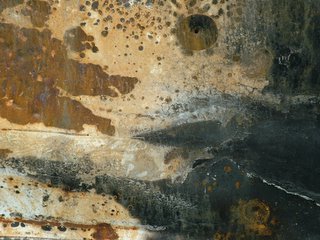
NOTE. I've been ill since December, so unable to work on anything new for my blog. I'll be back once I recover fully. Geoff.
APOLOGIES to anyone visiting who is expecting new posts. If a first-time visitor, please stay around and have a look at my previous posts - they are timeless, and can - I hope - be enjoyed at any time. Geoff Sanderson.
Saturday, August 27, 2005
No, for sheer, stark beauty in the landscape, winter takes a lot of beating. If you are the kind of walker or photographer who puts away the boots and camera at the first sniff of cold air, and heads for the best armchair and the TV schedules - let me show you a little of the beauty of my part of North Yorkshire, more specifically that of the Fountains Abbey and Studley Royal estate. This isn't the time to recount the long history of this fascinating place - more of that one day; suffice it to say that it is a World Heritage Site, visited by people from many parts of the world, and that we are lucky enough to live a short drive away from it.

Strolling through the deer park at Studley Royal on a bitingly-cold December day, I saw this estate farm-house 'caught' between the branches of a tree. Pulling off warm fleece gloves and standing still long enough to compose and shoot photographs in these conditions takes some dedication, I admit; but if I hadn't put up with the discomfort, I would have missed this image of that beautifull freize of trees set against the winter sky. In high summer this shot wouldn't have been worth taking, but in the depth of winter we can see the full beauty of the bare structure of the trees.
*********************
Fountains Abbey Ruins from the south
~~~~~~~~~~~~
The best days for dramatic photography are not those which start with bright sunlight and clear skies, but those which begin with thick clouds and heavy rainstorms. Quite often I find - in my part of England - that the storm passes by late afternoon, leaving fascinating varied and many-hued cloud masses with blue sky breaking through.
It was on such a day in March that I took this photograph of the abbey ruins. I wanted to combine the image of this magnificent field maple spreading its bare branches against the stormy sky, with that of the ruins sitting calm and steadfast in this valley - as they have continued to do for some 800 years now.
Symet-Tree
******
An awfull pun, I admit - but I always think of this as the symet-tree, for obvious reasons. Jill tells me that it's a specimen beech tree; all I know is that it keeps this perfect shape all year round. It is beautiful at any time of year, but reveals a special kind of ethereal loveliness on days like this, when freezing mist cloaks everything in mystery. If you look closely, you can see the ruined wall and window openings of the Abbey guest wing, emerging ghost-like through the skeleton of the tree - an image to be seen only in the depths of winter.
The Yew Hedge ~ Hoar Frost
~~~~~~~~~~~~~
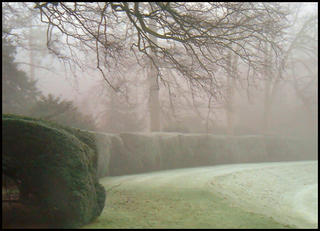
On the same day that I photographed the 'symet-tree' - a day of hoar frost, when one tried not to breathe too deeply, as every breath seared the lungs with intense cold - I was walking along, thinking longingly of hot tea and central-heating, when Jill grasped my arm and said 'Take a photograph of this for me, please.' With her artists eye, she had spotted the design possibilities of this yew hedge, which curved away round the nearby ornamental pond and slowly disappeared into the mist. We both found the contrast between the regularity of the hedge and the random nature of the dark branches, all modulated by the freezing mist, quite irresistable. Jill has been largely responsible for educating my eye like this, leading me to study composition as an aid to taking more appealing photographs.
.......................................................................................................................
Snowdrops
As Winter draws to a close, we have the flowers of early spring to look forward to; but before the golden delight of daffodills, there are the snowdrops - often pushing through late snowfall. Throughout the woods lining the valley of the River Skell - with Fountains Abbey at its head - countless thousands of them carpet the floor; so many that they reflect the light up into the bare branches, making the woods shimmer in the late winter sun.
%%%%%%%%%%
St Mary's, StudleyRoyal - now deconsecrated - was built as a private estate church in 1871, the architect being William Burgess, who was renowned as the master of the High Victorian Gothic Revival style. The interior is a masterpiece of design and colour, but few of the many thousands who pass it give it more than a glance, little guessing what lies inside. But it was the building itself - sitting boldly at the head of a drive which stretches through the deer park clear to Ripon Cathedral two miles away - which caught my eye, framed as it was by the bare branches of another magnificent tree set against a turbulent winter sky. With this tree in its summer foliage, the church would have been scarcely visible
~~~~~~~~~~~~~~~~~~~~~~~~~~~~~~~~~~~~~~~~~~~~~~~~~~~~~
Most images are completely satisfying in themselves - that is, if they have been captured with a view to presenting the subject so as to create in the viewer's mind the emotions that the photographer felt at the time he or she 'saw' the photograph. But sometimes an image - often when viewed again years after creation - promotes different feelings in the mind. With my recently-found interest in haiga, I find that words form, suggesting a haiku which will stand alone seperately from the image, but which has a special meaning when combined with it.
So it was with my final photograph in this 'Winter' collection. One December day we were walking around the large ornamental lake at the edge of the deer park, when a stray shaft of sunlight escaped from dark clouds, illuminating the stark branches set against the dark surface of the lake. In the distance a flock of gulls had settled in a line against the far shore, resting before continuing their journey. Only recently, while searching through my files for winter photographs, did I come across this image, and added the short poem to create this haiga.
~ a brief halt on this long journey - December afternoon ~

I hope that I've been able to convince you that winter can be the most beautiful of seasons ~ enjoy the next one!
*****************
Sunday, August 14, 2005

Flooded park-land ~ Beningbrough Hall
 Beningbrough Hall is an 18th-century country house with beautiful gardens and parkland, now in the care of the National Trust, just a few miles north of York. We set off one day for one of our regular visits - a stroll in the grounds, painting, photography, and lunch in the excellent restaurant. What we didn't realize was that the River Ouse, into which all the rivers draining the Yorkshire Dales run, was in flood. We discovered the extent when we reached the old wooden toll-bridge crossing the usually narrow, sluggish river.
Beningbrough Hall is an 18th-century country house with beautiful gardens and parkland, now in the care of the National Trust, just a few miles north of York. We set off one day for one of our regular visits - a stroll in the grounds, painting, photography, and lunch in the excellent restaurant. What we didn't realize was that the River Ouse, into which all the rivers draining the Yorkshire Dales run, was in flood. We discovered the extent when we reached the old wooden toll-bridge crossing the usually narrow, sluggish river.As we reached the centre of the bridge we realized that the river was now about half-a-mile wide; hurriedly parking the car, we went back to the bridge to take photographs. It was late afternoon, and the low sun picked out these lovely willow trees - usually high on the bank - casting interesting shadows on the water.
Crossing the bridge and looking upstream, we could see the flood-waters stretching across the Vale of York as far as the eye could see. True, floods cause so much misery to so many people, but as long as you are safe and not affected by them, they can add beauty to a normally dull landscape.
This part of the Vale consists of agricultural land, mostly grazing, and the farmers are well used to fairly regular flooding here. The plain stretches between the uplands of the Yorkshire Dales in the west and the low, rolling downland of the North York Moors to the east, so all the river waters have to drain through here, until they reach the North Sea via the River Humber.
This was the upstream view from the bridge, with the appropriately-named 'Goldfish' well inland from her usual mooring.
****

Jill and I weren't 'perfect strangers' of course - that was just poetic license, in order to give the work universal appeal.
********
Friday, August 12, 2005
Monday, August 08, 2005
Have I told you about the day I met her?
Not for a long time,
but I’m sure you’re going to tell me again.
You must be feeling better!
It was a day in late October
when the skies were full of rain,
and I hurried over the moor
looking for shelter.
Late October? Are you sure?
The last time you told it,
it was mid-September.
You never pay attention - and don’t interrupt.
That girl, and those eyes! Do you think
I wouldn’t remember?
I remember ‘Those are pearls that were his thighs
And nothing doth remain ...’
... I sometimes think you’ll drive me insane.
... I heard a sweet sound
drifting, drifting on the breeze ...
... and then you saw, below you
in a belt of trees ...
... a small hut, with such a curious door.
As I drew near, I could see that it was
woven like a wattle fence.
Here, let me prop you up a little -
I don’t like that rattle in your throat.
They had left the door ajar
and inside, someone was lazily playing
a twelve-string guitar, slowly fingering,
lingering over each note.
You shouldn’t keep tormenting yourself.
Stop this, it doesn’t make any sense!
I pushed open the door,
and saw her sitting there,
with the dead child on the floor;
That girl with the pale, pale face
that girl with the blueberry hair,
and eyes the colour of silence.
Sunday, August 07, 2005
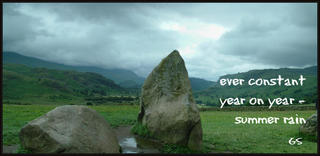
We recently spent a few days away in the Lake District, in North West England, around 100 miles away from our home. This is a land of lakes, mountains and rivers - very beautiful, but also very wet for a good deal of the time; they need the rain to keep those lakes full.
We spent one memorable day at this Neolithic monument, Castlerigg Stone Circle, near Keswick. There are 40 stones arranged in a rough circle, with ten more in a small rectangle within. The image above is composed of two photographs linked to form a panorama, and the large rock faces due south.
We had almost continuous rain that day, and I had to work hard to get my photographs. I had the camera set up on my tripod, and I squatted on a low stool, holding an umbrella over the camera, struggling to set the controls and take the photos - while the rain dribbled down my neck. We have to suffer for our art sometimes.
In the haiku, I wanted to link the idea of the constant presence of these rocks - at least, for around 3500 years anyway - with the certainty of rain in summer in this hill country.



